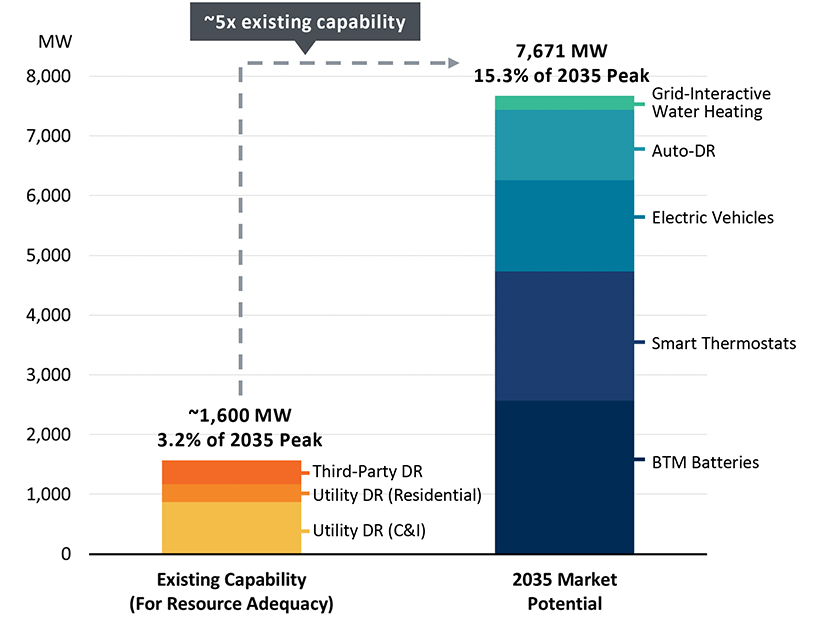
California could save more than $750 million a year in power costs through increased use of virtual power plants (VPPs), according to a new study by The Brattle Group and GridLab.
The study found that more than 7,500 MW of VPP capacity could be deployed cost-effectively across California over the next decade, accounting for more capacity than the state’s largest power plant or the peak demand of Los Angeles.
“By 2035, California’s VPP potential will exceed 15% of [statewide] peak demand. That’s five times the existing capability,” the study, which examines VPP deployment potential by 2035, reads. “By providing these services to the power system, VPPs can make significant contributions to grid reliability while directly compensating those consumers who participate.”
Changing weather conditions, increasing loads, dependance on intermittent generation and growing demand for electrification are just some of the factors that have stressed California’s ability to meet its resource adequacy requirements in a timely and cost-effective manner, the report said.
VPPs use an aggregated network of distributed energy technologies such as batteries and electric vehicle chargers to feed power back into the system and provide financial incentive to participating customers. The idea is that, in addition to increasing reliability, virtual systems reduce reliance on fossil fuels during times of peak demand.
Almost all the state’s VPP capacity is traditional demand response, only a fraction of which is used to provide resource adequacy, the study says. But California is pushing for the increased adoption of VPPs with Senate Bill 1305, which would require the state’s Public Utility Commission to establish a VPP capacity procurement requirement by March 2026.
And new technologies are emerging. Last year, Sunrun, a residential solar installer, partnered with Pacific Gas and Electric to enroll 8,500 residential battery owners in a VPP that provided nearly 30 MW of power during summer evenings. Also last year, the Sacramento Municipal Utilities District partnered with Ford, BMW and GM to develop a pilot that manages the charging of participating EVs to minimize costs to the power system.
Study Scope
Researchers focused the study on five dispatchable consumer technologies: smart thermostat-based air-conditioning control, behind-the-meter batteries, residential EV charging, grid-interactive water heating, and automated demand response (auto-DR) for large commercial buildings and industrial facilities.
The study employed a FLEX model, designed by The Brattle Group to assess load flexibility potential, to determine that all five technologies would contribute to peak demand reduction. Batteries, EVs and electric water heating could aid in load shifting, while smart thermostats and auto-DR could reduce energy consumption and save money.
Roughly $550 million in system savings would be retained by customers, the study found. Broken down, VPPs would avoid $417 million in generating capacity, $194 million in transmission, $107 million in energy and $37 million in distribution. A household participating in all four residential VPP options considered could receive participation payments of $500 to $1,000 per year.
While not quantified in the study, researchers also found that VPPs could help to reduce lengthy resource interconnection delays and “unprecedented uncertainty” in load forecasting.
The Brattle Group also pointed to VPP options not considered in the study that could increase capacity potential, including vehicle-to-grid technologies, targeted energy efficiency, smart panels and thermal energy storage.
The advancement of VPPs would rely on customer participation.
“The share of customers that adopt flexible technologies such as EVs, batteries and smart thermostats over the next decade will establish the foundation for VPP program eligibility. The state will need a persistent focus on advancing policies that promote adoption in these areas for our potential estimates to materialize,” the report reads.
Greater reliance on VPPs also would require more frequent use of said resources. Achieving 7,500 MW of net peak demand reduction would require 114 hours of VPP dispatch per year, six consecutive hours of dispatch on the peak day, and five months of the year, the study estimated.
“By improving the utilization of distributed energy technologies, VPPs reduce the need for new grid resources that otherwise would sit unused for many hours of the year,” the study reads. “If this vision is achieved, the result will be a reliable and more affordable power grid for Californians.”

